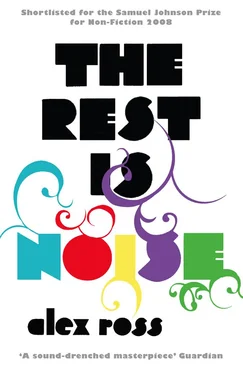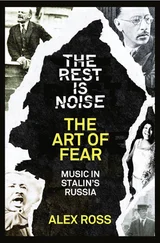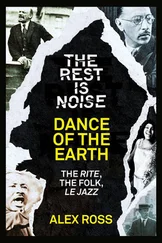Wozzeck takes out his knife as the timpani pound away at the fatal note. He kills Marie suddenly and unceremoniously, without much commentary from the orchestra. Once he rushes from the scene, though, the orchestra reenacts the death with an incredible succession of sounds. The B returns, humming almost inaudibly on a muted horn. Then instrument after instrument joins in on the same pitch, creating a super-bright beam of tone. As the composer and theorist Robert Cogan has demonstrated, by way of spectrographic imaging of sounds, the scoring of this single note produces an exceptionally rich mass of overtones, with a chord of B major at its root. After a climactic dissonant chord and a shuddering death-rhythm on the bass drum, the crescendo begins again, now with a battery of percussion added, so that clean overtones give way to a toneless wash of noise. “Like the murder scene,” Cogan writes, “this climactic passage reaches the ultimate in human limits, extending from the threshold of audibility to the threshold of pain.”
As if with a rapid cinematic cut, the scene changes to a tavern, where an out-of-tune upright piano is playing a rickety polka, employing the same rhythm that has just been heard on the bass drum. Wozzeck is seated at one of the tables, blood dripping from his hand. The locals stop their wild dancing to accuse him of murder, and he rushes back to the pond to wash away the evidence. As the orchestra plays rippling transpositions of a six-note chord, he sinks beneath the waves. The Captain and the Doctor walk by a moment later, marveling at the uncanny stillness of the scene. It is as if they were studying a canvas at a Secession exhibition.
Now comes the masterstroke. At the end of the next-to-last scene, the orchestra delivers a kind of wordless oration, which, in Berg’s own words, is “a confession of the author who now steps outside the dramatic action on the stage … an appeal to humanity through its representatives, the audience.” There is a palpable break in the musical language, as Berg makes use of a piece that he wrote back in 1908 or 1909—a sketch for a Mahlerian Sonata in D Minor. (The composer associated this music with the singer Helene Nahowski, whom he married in 1911, and he apparently inserted it in the opera at her request.) Dissonance stages a counterstrike: trombones deliver a stentorian “We poor people,” twelve woodwinds mass together in a twelve-note chord, and sheets of sound in the percussion replicate the terror of Marie’s murder. Finally, the bass instruments pound out a rising fourth, and D minor crashes back in. All this sounds like something more than a lament for two human beings; it may be a tribute to what Thomas Mann called the “worldwide festival of death”—the Great War itself.
The ending is breathtakingly bleak. We see Wozzeck and Marie’s child riding his hobby horse, oblivious to the fact that his mother is lying dead nearby. Berg, in a lecture on the opera, pointed out that the coda links up with the beginning; likewise, it is all too plausible that this child will grow up to be a replica of his father. A slow fadeout on an oscillating pair of chords points toward a despairing conclusion. As the chords rock back and forth, though, there are passing glimpses of G major, like transitory glimmerings of light.
Compare the ending of Debussy’s Pelléas, where Mélisande dies within sight of her newborn baby while the serving women fill the room. “It’s the poor little thing’s turn now,” says King Arkel. The onlooker is left to imagine the fate of these orphans of the fin de siècle: perhaps they will perpetuate the cycle of misery, breeding violence from violence, or perhaps they will escape to some great open city, where the children of unhappy families start anew.
3 DANCE OF THE EARTH
The Rite, the Folk, le Jazz
May 29, 1913, was an unusually hot day for Paris in the spring: the temperature reached eighty-five degrees. By late afternoon a crowd had gathered in front of the Théâtre des Champs-Élysées, on the avenue Montaigne, where Serge Diaghilev’s Ballets Russes was holding its spring gala. “There, for the expert eye, were all the makings of a scandal,” recalled Jean Cocteau, then twenty-three. “A fashionable audience in décolletage, outfitted in pearls, egret headdresses, plumes of ostrich; and, side by side with the tails and feathers, the jackets, head-bands, and showy rags of that race of aesthetes who randomly acclaim the new in order to express their hatred of the loges … a thousand nuances of snobbery, super-snobbery, counter-snobbery …” The better-heeled part of the crowd had grown wary of Diaghilev’s methods. Disquieting rumors were circulating about the new musical work on the program—The Rite of Spring, by the young Russian composer Igor Stravinsky—and also about the matching choreography by Nijinsky. The theater, then brand-new, caused a scandal of its own. With its steel-concrete exterior and amphitheater-like seating plan, it was deemed too severe, too Germanic. One commentator compared it to a zeppelin moored in the middle of the street.
Diaghilev, in a press release, promised “a new thrill that will doubtless inspire heated discussion.” He did not lie. The program began innocuously, with a revival of the Ballets Russes’ Chopin fantasy Les Sylphides. After a pause, the theater darkened again, and high, falsetto-like bassoon notes floated out of the orchestra. Strands of melody intertwined like vegetation bursting out of the earth—“a sacred terror in the noonday sun,” Stravinsky called it, in a description that had been published that morning. The audience listened to the opening section of the Rite in relative silence, although the increasing density and dissonance of the music caused mutterings, titters, whistles, and shouts. Then, at the beginning of the second section, a dance for adolescents titled “The Augurs of Spring,” a quadruple shock arrived, in the form of harmony, rhythm, image, and movement. At the outset of the section, the strings and horns play a crunching discord, consisting of an F-flat-major triad and an E-flat dominant seventh superimposed. They are one semitone apart (F-flat being the same as E-natural), and they clash at every node. A steady pulse propels the chord, but accents land every which way, on and off the beat:
one two three four five six seven eight
one two three four five six seven eight
one two three four five six seven eight
one two three four five six seven eight
Even Diaghilev quivered a little when he first heard the music. “Will it last a very long time this way?” he asked. Stravinsky replied, “Till the end, my dear.” The chord repeats some two hundred times. Meanwhile, Nijinsky’s choreography discarded classical gestures in favor of near-anarchy. As the ballet historian Lynn Garafola recounts, “The dancers trembled, shook, shivered, stamped; jumped crudely and ferociously, circled the stage in wild khorovods.” Behind the dancers were pagan landscapes painted by Nicholas Roerich—hills and trees of weirdly bright color, shapes from a dream.
Howls of discontent went up from the boxes, where the wealthiest onlookers sat. Immediately, the aesthetes in the balconies and the standing room howled back. There were overtones of class warfare in the proceedings. The combative composer Florent Schmitt was heard to yell either “Shut up, bitches of the seizième!” or “Down with the whores of the seizième!”—a provocation of the grandes dames of the sixteenth arrondissement. The literary hostess Jeanne Mühlfeld, not to be outmaneuvered, exploded into contemptuous laughter. Little more of the score was heard after that. “One literally could not, throughout the whole performance, hear the sound of music,” Gertrude Stein recalled, no doubt overstating for effect. “Our attention was constantly distracted by a man in the box next to us flourishing his cane, and finally in a violent altercation with an enthusiast in the box next to him, his cane came down and smashed the opera hat the other had just put on in defiance. It was all incredibly fierce.”
Читать дальше












